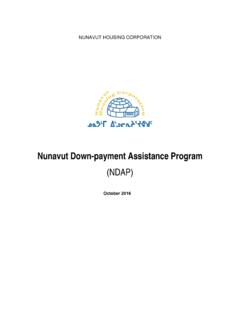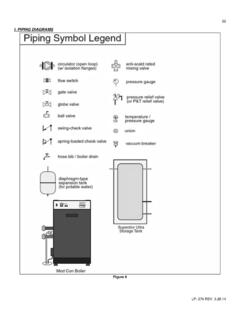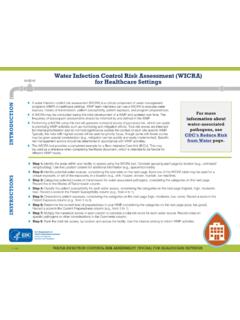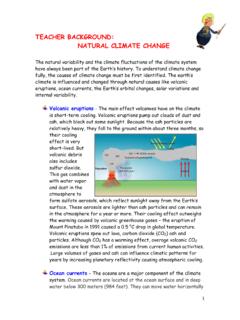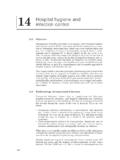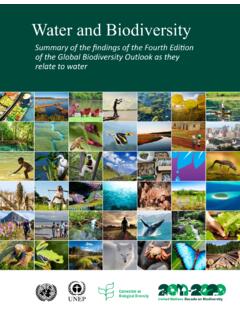Transcription of 4. Modes of Transmission - Nunavut
1 ! 4 - 14. Modes of TransmissionBreaking the chain at the mode of Transmission is one of the most important ways to interrupt the spread of infection. This is where infection prevention and control strategies can be most successful. Microorganisms are transmitted in health care settings by four main routes: Contact Droplet Airborne Common vehicleRoutine Practices are designed to reduce the risk of vary by size, the length of time that they survive on surfaces or in the air and the method of getting around. These factors plus the variability in virulence, the complications of treatment and the complex symptoms may require special treatment of some patients.
2 These Additional Precautions are grouped, based on the mode of Transmission of the infectious agent. See: Section 7: Additional Precautions Section 9: Personal Protective Equipment. ! 4 - 2 Table of Survival Times of Microorganisms on Hard Inanimate SurfacesOrganism Survival Time Adenovirus Up to 3 monthsClostridium difficile Up to 5 monthsCoronovirus 3 hoursE. coli Up to 16 monthsInfluenza 1-2 daysMRSA Up to 7 monthsM. tuberculosis Up to 4 monthsNorovirus Up to 7 daysRSV Up to 6 hoursBMC Infectious Diseases 2006: 6: 130 Contact Contact is the most frequent mode of Transmission of health care associated infections and can be divided into: direct and indirect .
3 An example of contact transmitted microorganisms is Noroviruses which are responsible for many gastrointestinal infections. Direct: involves direct body surface to body surface contact and physical transfer of microorganism between an infected or colonized person to another person by touch. indirect : involves contact between a person and a contaminated object. This is often a result of unclean hands contaminating an object or environment. The microorganism remains on this surface to be picked up by the next person who touches it. ! 4 - 3 Droplet Transmission occurs when droplets containing microorganisms generated during coughing, sneezing and talking are propelled through the air.
4 These microorganisms land on another person, entering that new person s system through contact with his/her conjunctivae, nasal mucosa or mouth. These microorganisms are relatively large and travel only short distances (up to 6 feet/2 metres). However these infected droplets may linger on surfaces for long periods of time, so these surfaces (within the range of the coughing/sneezing person) will need additional cleaning. For this reason there may be both Droplet and Contact Precautions required at the same of microorganisms that are spread by droplet Transmission are: influenza, colds, respiratory syncytial virus (RSV) and some organisms causing pneumonia.
5 ! 4 - 4 Airborne RESPIRATORYHYGIENEP rotect the healthof others`x8ixc3Nq5goEp4f5 wkoEp4f9lDepartment of Health and Social Servicesxi6tEi4f5 nlmNhx3i6xyt5 ckwq5txd9lQ5 nS7uMs4r5 IFYOU ARE ILL,AVOIDVISITINGFAMILY AND AF5 dw6ho AF9 8 5, c 5 ezw9 8 5 v4rst4nj5 havetosneezeorcough, cover your mouth andnose with v4rst4n6 ni4fF7j5 of soiled tissues in the , Nw5 gw1k5~9lA s=? 8 5 wfy1 3lA bEs3 FQixCFs4 dw6h3 FQlA 8 do not have atissue, turnyour face into yourshoulderorthe bendofyour elbow to [Zt5 sxnZJc5b4r5. sxnstbcq2X5 wu6bcq2X9 8 5, dW3DC k5 gdnw0 Jtc3gu4 xg1 your hands often.]
6 If soap and water are not available, use an antiseptic , wMQ/t5 Wc8NE/t9 8 5 S Ex6bwomvw8N3lQ5 RESPIRATORYHYGIENEP rotect the healthof others`x8ixc3Nq5goEp4f5 wkoEp4f9lDepartment of Health and Social Servicesxi6tEi4f5 nlmNhx3i6xyt5 ckwq5txd9lQ5 nS7uMs4r5 IFYOU ARE ILL,AVOIDVISITINGFAMILY AND AF5 dw6ho AF9 8 5, c 5 ezw9 8 5 v4rst4nj5 havetosneezeorcough, cover your mouth andnose with v4rst4n6 ni4fF7j5 of soiled tissues in the , Nw5 gw1k5~9lA s=? 8 5 wfy1 3lA bEs3 FQixCFs4 dw6h3 FQlA 8 do not have atissue, turnyour face into yourshoulderorthe bendofyour elbow to [Zt5 sxnZJc5b4r5.]
7 Sxnstbcq2X5 wu6bcq2X9 8 5, dW3DC k5 gdnw0 Jtc3gu4 xg1 your hands often. If soap and water are not available, use an antiseptic , wMQ/t5 Wc8NE/t9 8 5 S Ex6bwomvw8N3lQ5 RESPIRATORYHYGIENEP rotect the healthof others`x8ixc3Nq5goEp4f5 wkoEp4f9lDepartment of Health and Social Servicesxi6tEi4f5 nlmNhx3i6xyt5 ckwq5txd9lQ5 nS7uMs4r5 IFYOU ARE ILL,AVOIDVISITINGFAMILY AND AF5 dw6ho AF9 8 5, c 5 ezw9 8 5 v4rst4nj5 havetosneezeorcough, cover your mouth andnose with v4rst4n6 ni4fF7j5 of soiled tissues in the , Nw5 gw1k5~9lA s=? 8 5 wfy1 3lA bEs3 FQixCFs4 dw6h3 FQlA 8 do not have atissue, turnyour face into yourshoulderorthe bendofyour elbow to [Zt5 sxnZJc5b4r5.]
8 Sxnstbcq2X5 wu6bcq2X9 8 5, dW3DC k5 gdnw0 Jtc3gu4 xg1 your hands often. If soap and water are not available, use an antiseptic , wMQ/t5 Wc8NE/t9 8 5 S Ex6bwomvw8N3lQ5 .Cover your mouth and nose with a tissue..Throw tissues in the trash. : .No tissue: sneeze or cough in your sleeve..Wash your hands or use hand sanitizer. Cover your coughs and sneezesAirbone Transmission of infectious agents occurs either by: Airborne droplet nuclei (small particles of 5 mm or smaller in size) Dust particles containing infectious agents.
9 Microoganisms carried in this manner remain suspended in the air for long periods of time and can be dispersed widely by air currents. Because of this, there is risk that all the air in a room may be contaminated. Some examples of microorganisms that are transmitted by the airborne route are: M. tuberculosis, rubeola, varicella and Vehicle Applies to microorganisms that are transmitted by contaminated items such as food, water, medications, medical devices and equipment. To inhibit the Transmission of microorganisms by this mode: Clean patient equipment between uses with different patients Handle, store and prepare food properly Careful store and draw up doses of medication from multidose medication vials.
10

